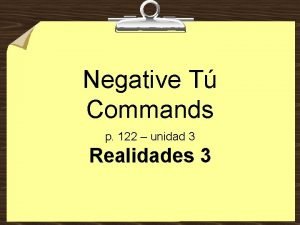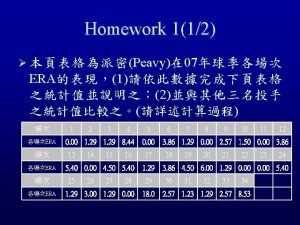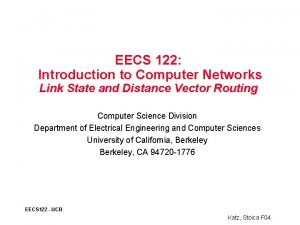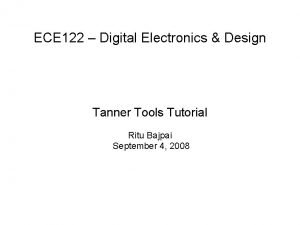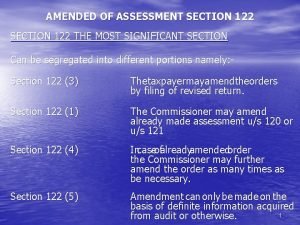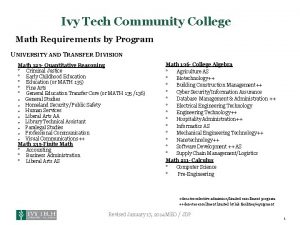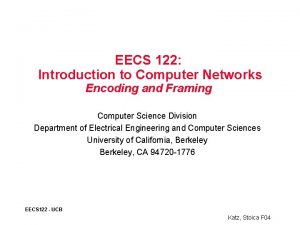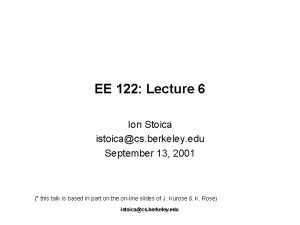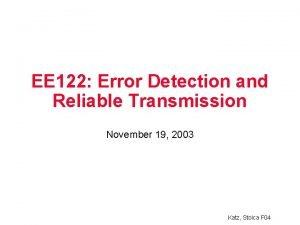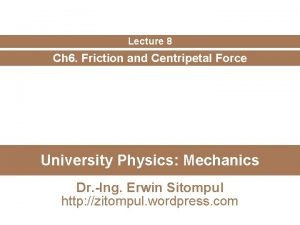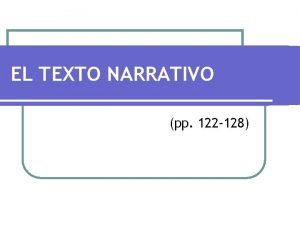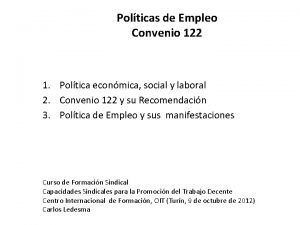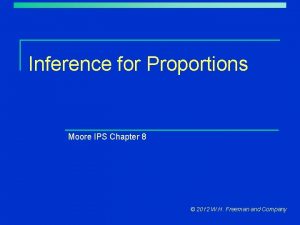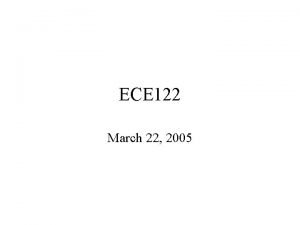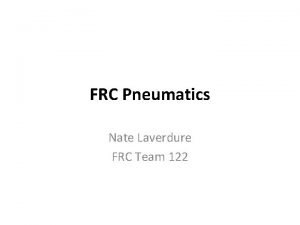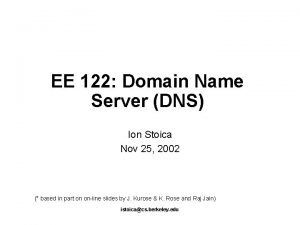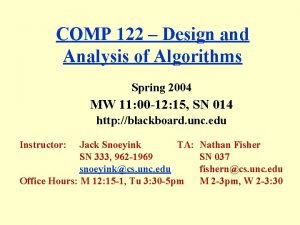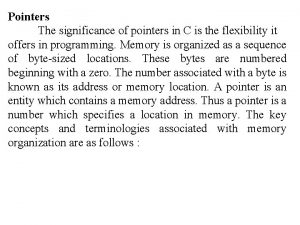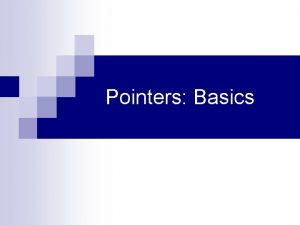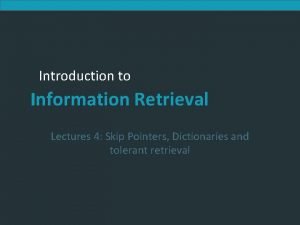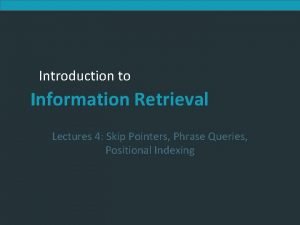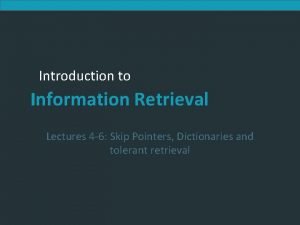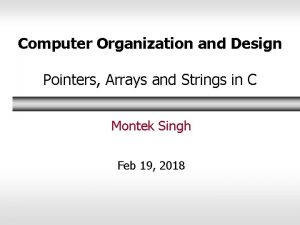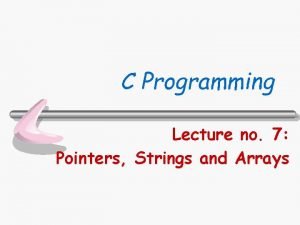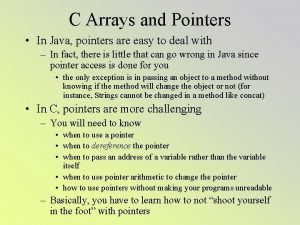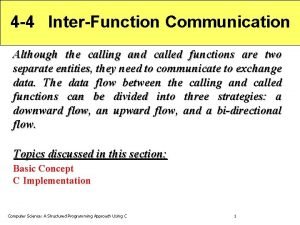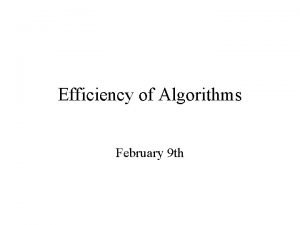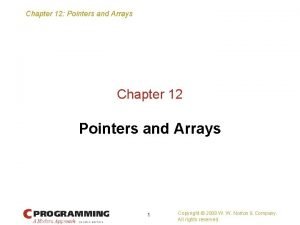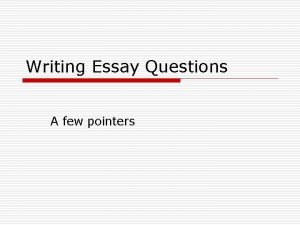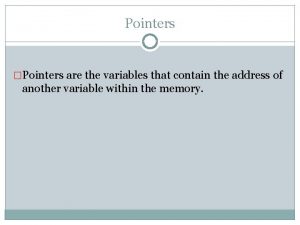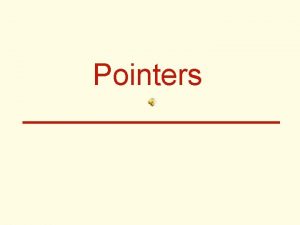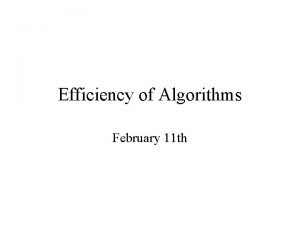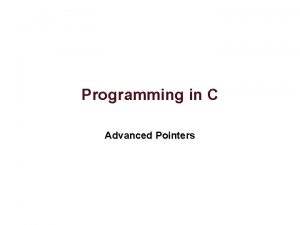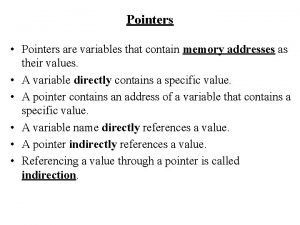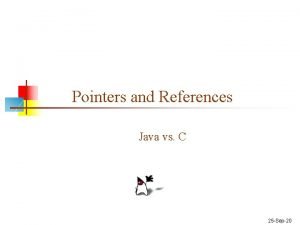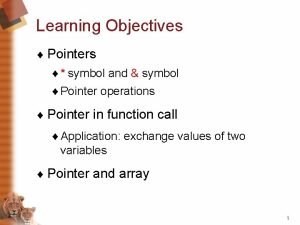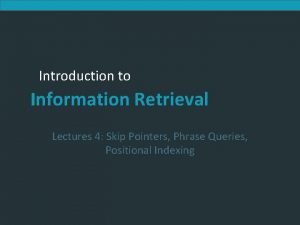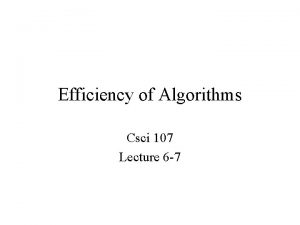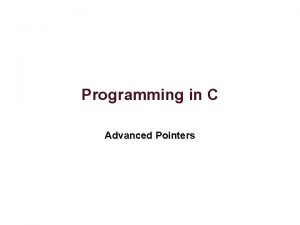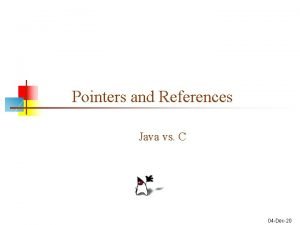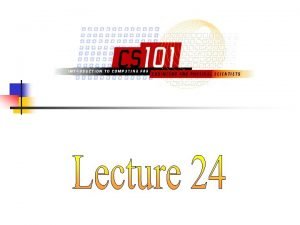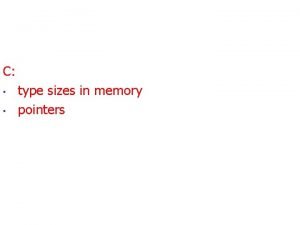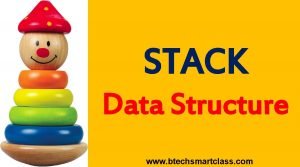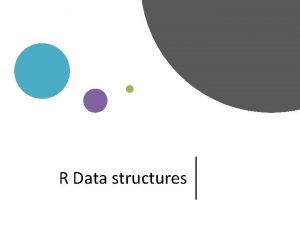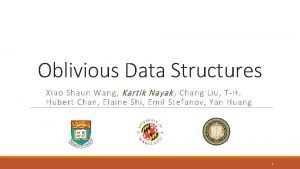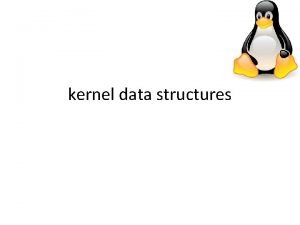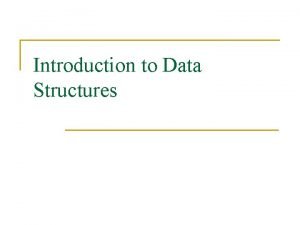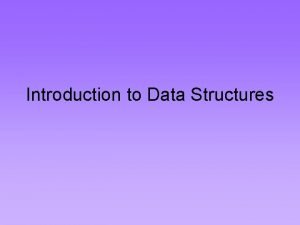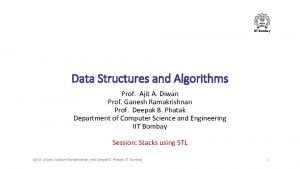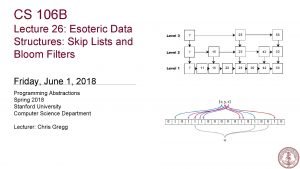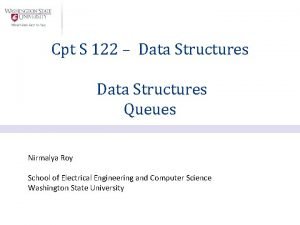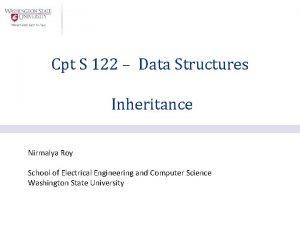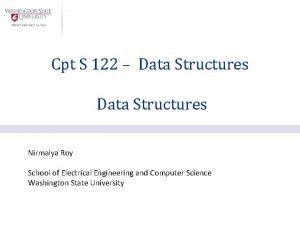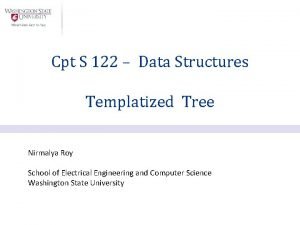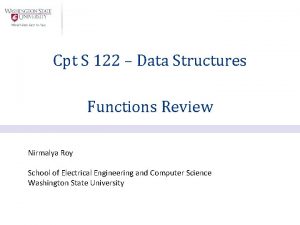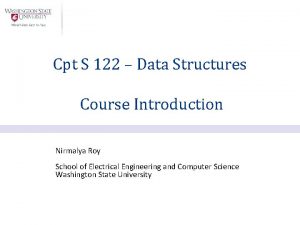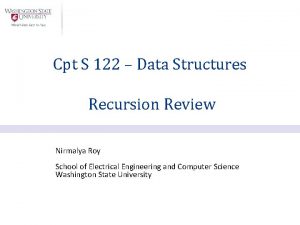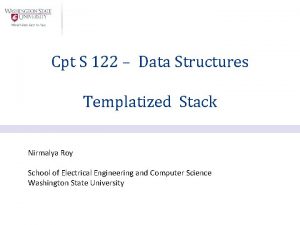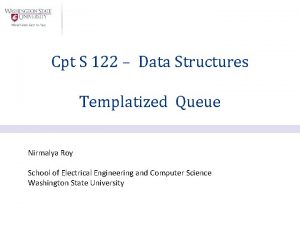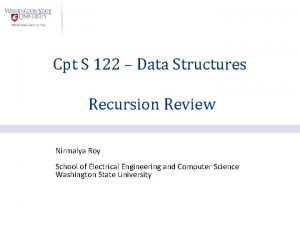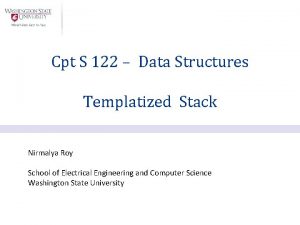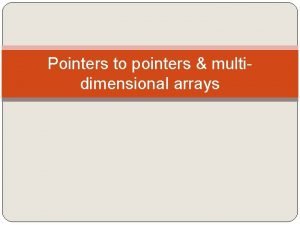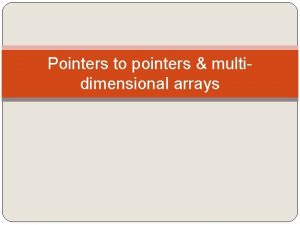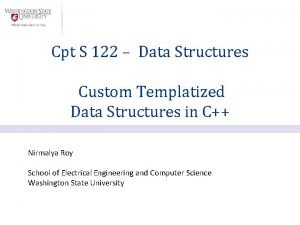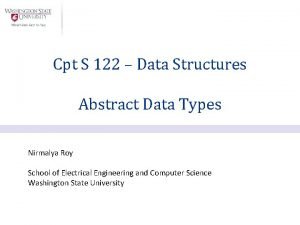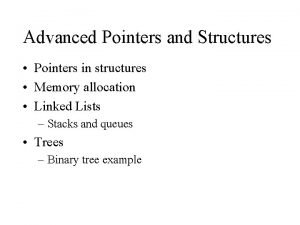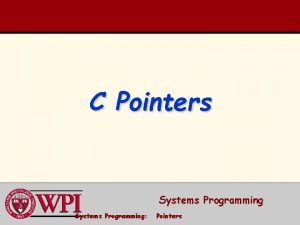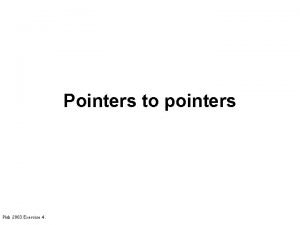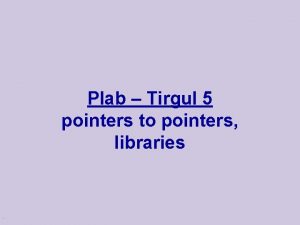Cpt S 122 Data Structures Pointers Nirmalya Roy












































![Pointer Expressions and Pointer Arithmetic n n Assume that array int v[5] has been Pointer Expressions and Pointer Arithmetic n n Assume that array int v[5] has been](https://slidetodoc.com/presentation_image_h2/950b24770d70bb23a81ebb3e4b9a461e/image-45.jpg)






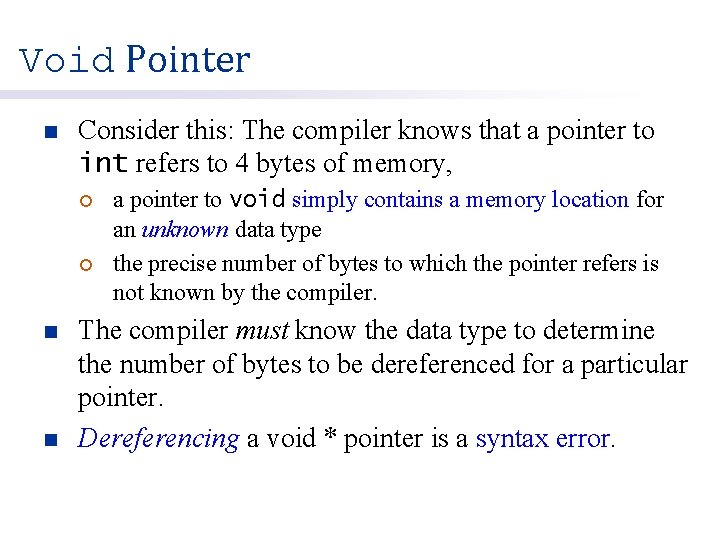
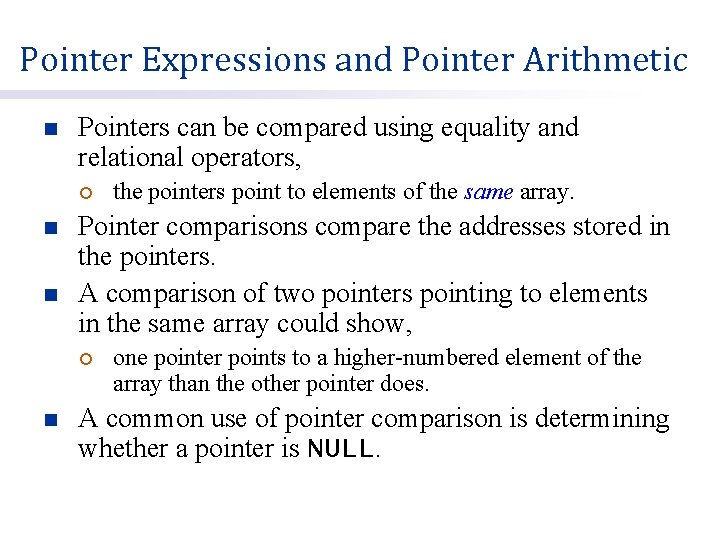
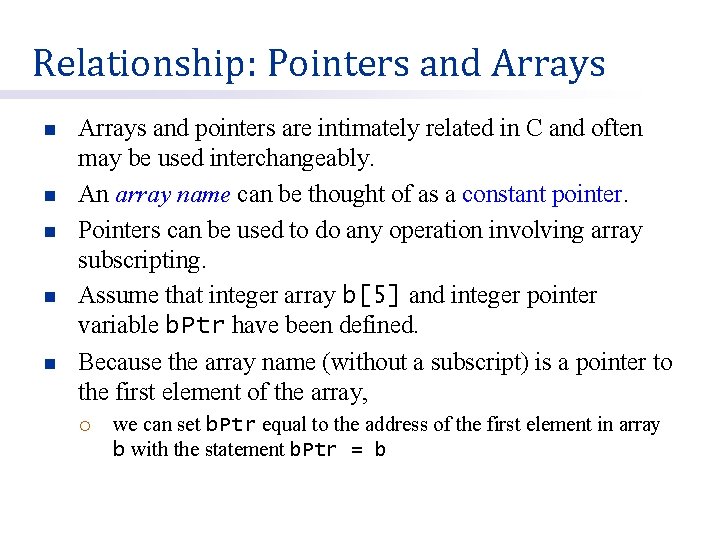

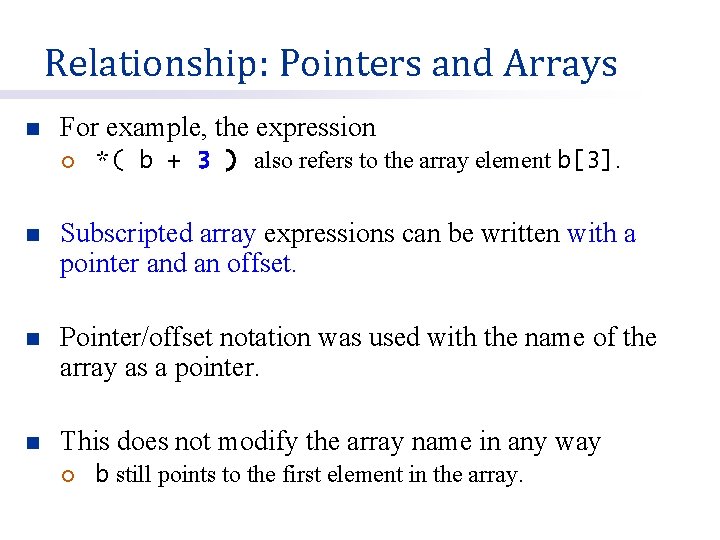
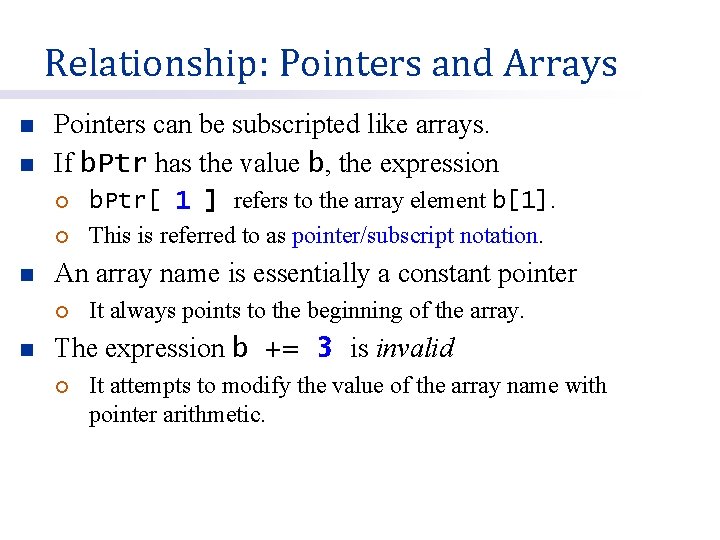
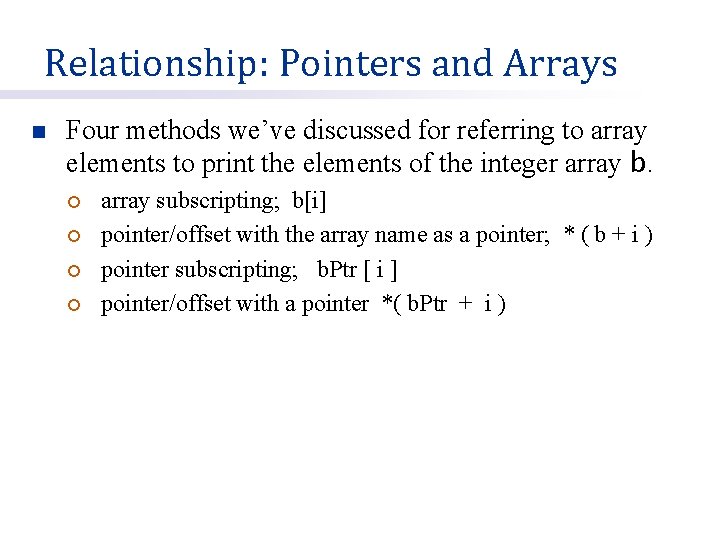



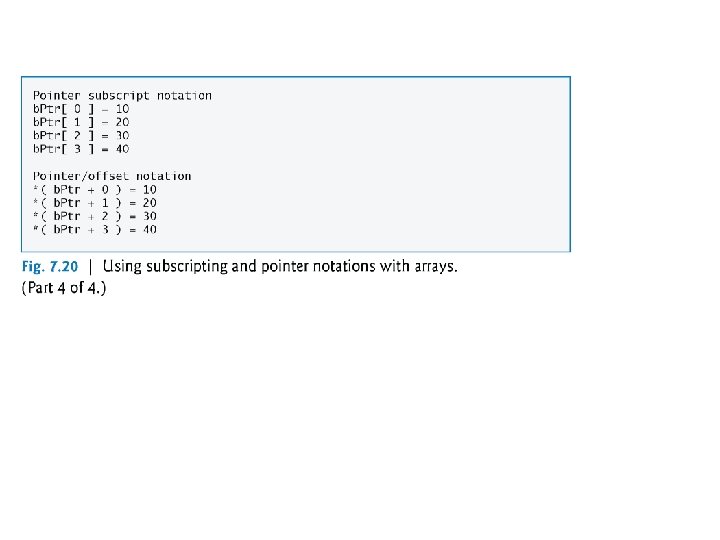
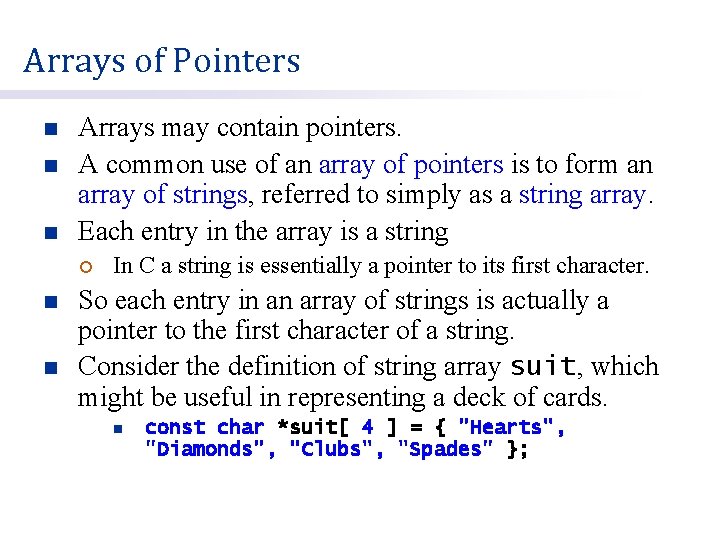
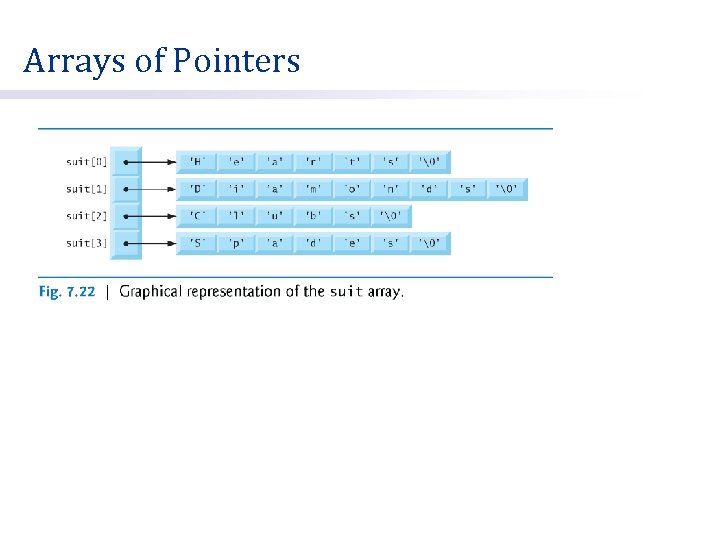
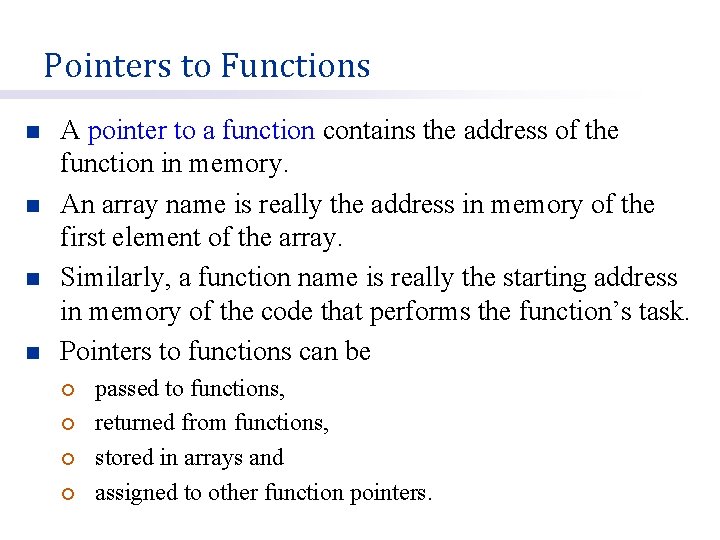
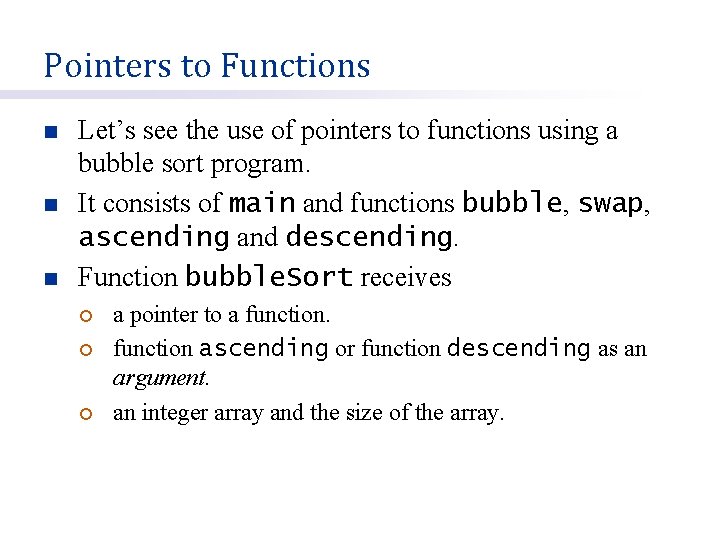
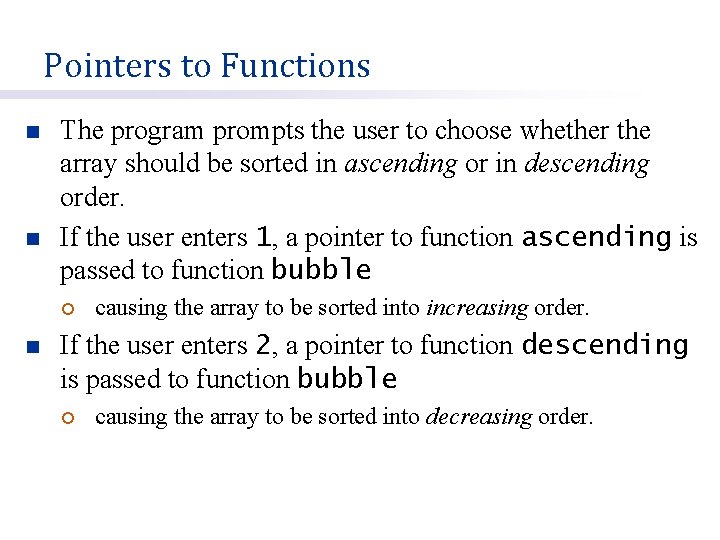
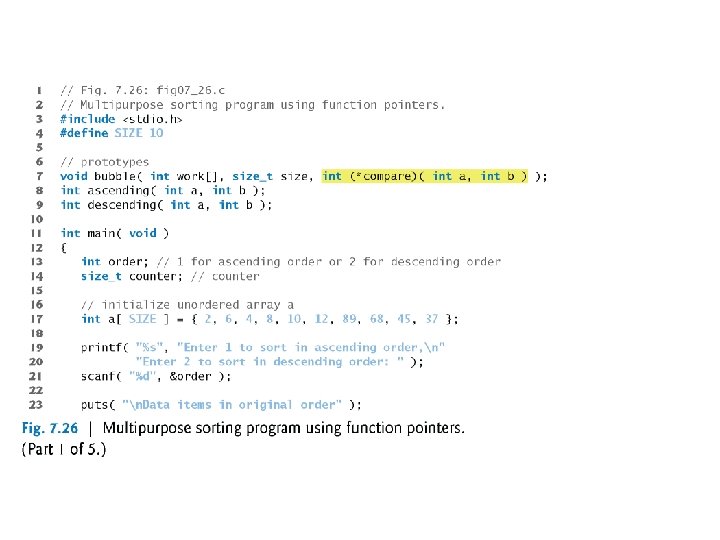
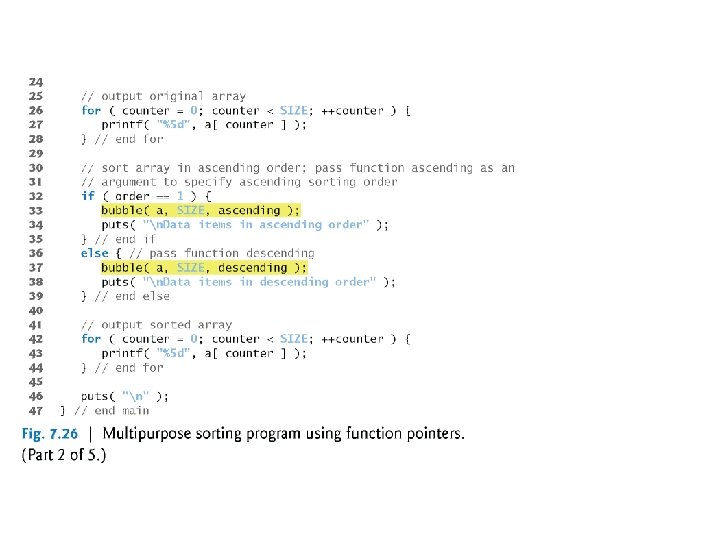
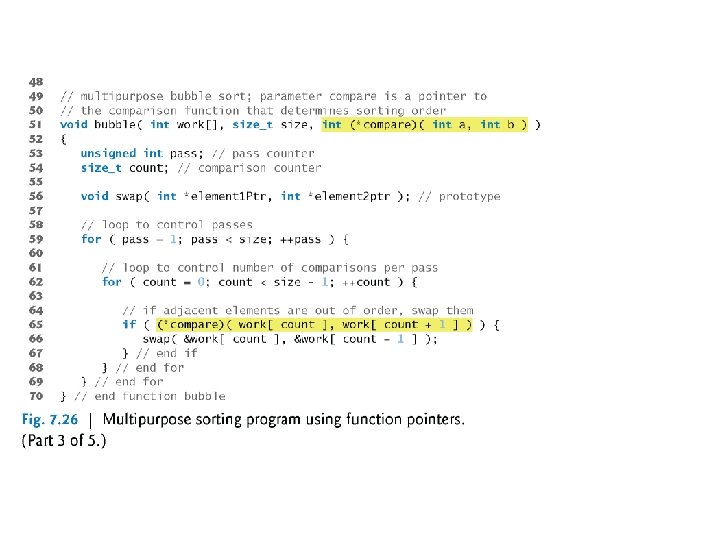




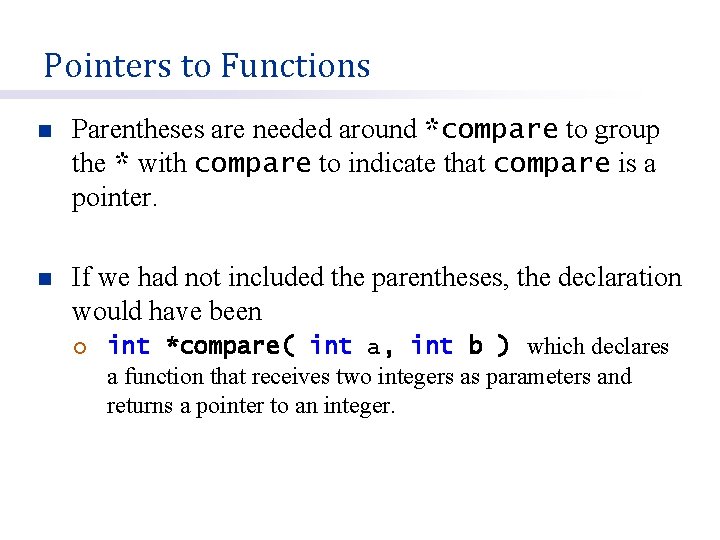
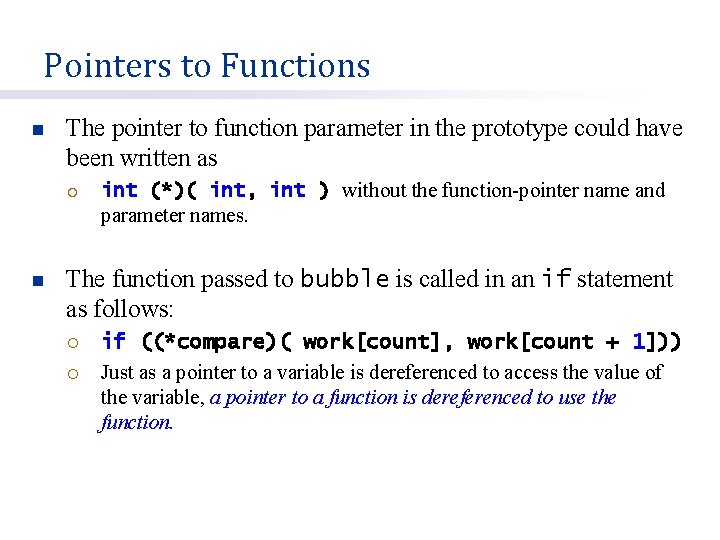
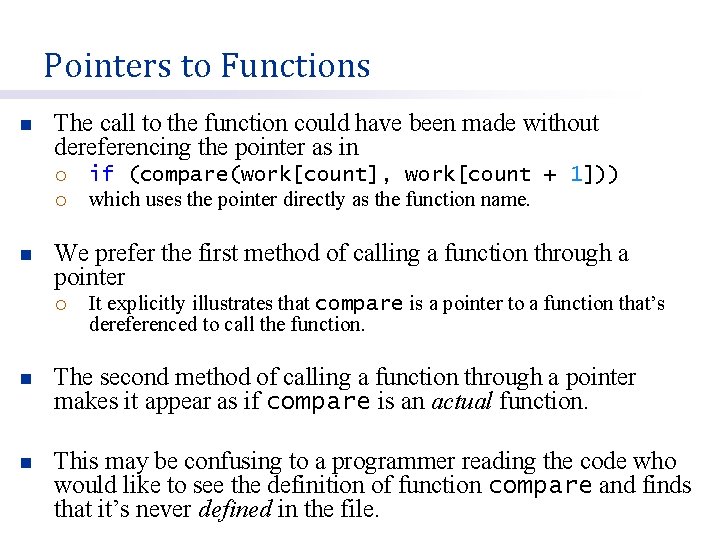

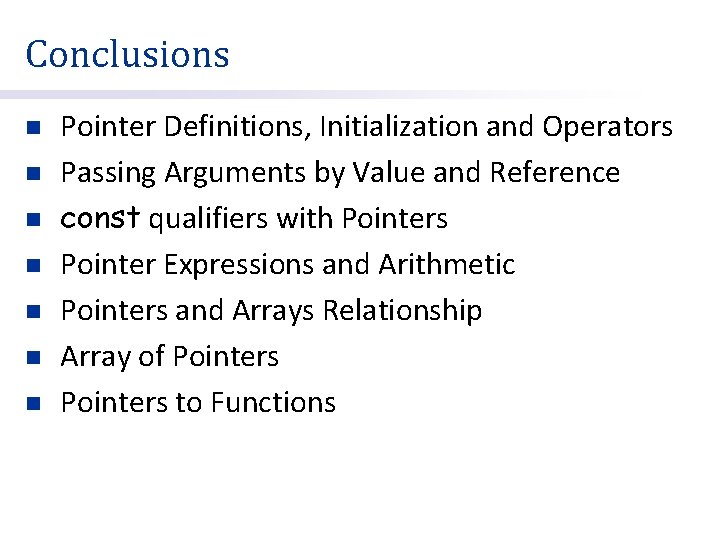
- Slides: 79

Cpt S 122 – Data Structures Pointers Nirmalya Roy School of Electrical Engineering and Computer Science Washington State University

Topics n n n n n Definitions and Initialization Pointer Operators Passing Arguments to Functions by Reference const qualifiers with Pointers sizeof operator Pointer Expressions and Arithmetic Relationship between Pointers and Arrays Array of Pointers to Functions

Pointer n n One of the most powerful features of C. Enables programs to simulate pass-by-reference. ¡ n pass functions between functions. For creating and manipulating dynamic data structures (i. e. , data structures that can grow and shrink at execution times). ¡ Linked lists, queues, stacks, trees.

Pointer Variable Definitions and Initialization n n Pointers are variables whose values are memory addresses. Normally, a variable directly contains a specific value. ¡ n A pointer contains an address of a variable that contains a specific value. ¡ n A variable directly references a value. A pointer indirectly references a value. Indirection means referencing a value through a pointer.

Pointer Variable Definitions and Initialization n Directly and indirectly referencing a variable count 7 count. Ptr count Memory Location of 7 7 count directly references a variable that contains the value 7. Pointer count. Ptr indirectly references a variable that contains the value 7.

Pointer Variable Declaration n n Syntax: <data type> *<pointer variable>; Example: int *count. Ptr; ¡ ¡ n What is the difference between count and count. Ptr? ¡ int *count. Ptr, count; ¡ specifies that variable count. Ptr is of type int * (i. e. , a pointer to an integer) the variable count is defined to be an int, not a pointer to an int. ¡ n “count. Ptr is a pointer to an int” “count. Ptr points to an object of type int” Naming convention for pointers ¡ Include the letter ptr in pointer variable names

Pointer Variable Initialization n Pointers should be initialized either when they’re defined or in an assignment statement. ¡ ¡ Values: NULL, 0, or an address. A pointer with the value NULL points to nothing. NULL is a symbolic constant defined in <stddef. h> header. The value 0 is the only integer that can be assigned directly to a pointer variable.

Example of NULL Pointers n The null pointer is the only integer literal that may be assigned to a pointer ¡ ¡ n The null pointer is never a valid target ¡ n If you try to dereference the null pointer, you will get a segmentation fault. The null pointer is typically used as a placeholder to initialize pointers ¡ n int * ptr = 0; // OK. assignment of null pointer to p. int * z; z = 900; // BAD! Cannot assign other literals to pointers. If you make sure your pointer is ALWAYS set to either a valid target, or to the null pointer, then you can test for it if (ptr != 0) //safe to dereference printf(“%d”, *ptr); To prevent dangling pointers

Pointer Operators n n The &, or address operator, is a unary operator that returns the address of its operand. For example, assuming the definitions n int y = 5; int *y. Ptr; the statement n n y. Ptr = &y; assigns the address of the variable y to pointer variable y. Ptr. Variable y. Ptr is then said to “point to” y. y. Ptr y Location 500000 5 y. Ptr “points to” y. 600000 y Location 600000 5

Pointer Operators (Cont. ) The Indirection (*) Operator n The unary * operator, commonly referred to as the indirection operator or dereferencing operator ¡ ¡ n returns the value of the object to which its operand (i. e. , a pointer) points. For example, printf( "%d", *y. Ptr ); prints the value of variable y, namely 5. Using * in this manner is called dereferencing a pointer.

Passing Arguments to Functions by Reference n There are two ways to pass arguments to a function ¡ ¡ n n Note. All arguments in C are passed by value. Many functions require the capability to modify variables in the caller or to pass a pointer to a large data object to avoid the overhead of passing the object by value ¡ n pass-by-value/call-by-value and pass-by-reference/call-by-reference. pass-by-value incurs the time and memory overheads of making a copy of the object We can simulate pass-by-reference using pointers.

Passing Arguments to Functions by Value void swap(int a, int b) { int temp; temp = a; a = b; b = temp; } void main(void) { int x = 3; y = 5; printf(“x = %d, y = %dn”, x, y); swap(x, y); printf(“x = %d, y = %dn”, x, y); }

Passing Arguments to Functions by Reference void swap(int *a, int *b) { int temp; temp = *a; *a = *b; *b = temp; } void main(void) { int x = 3; y = 5; printf(“x = %d, y = %dn”, x, y); swap(&x, &y); printf(“x = %d, y = %dn”, x, y); }

Example of pass-by-value


Example of pass-by-reference


Example of pass-by-reference n A function receiving an address as an argument must define a pointer parameter to receive the address. n For example, the header for function cube. By. Reference is: ¡ n void cube. By. Reference( int *n. Ptr ) The header specifies that cube. By. Reference receives the address of an integer variable as an argument, ¡ stores the address locally in n. Ptr and does not return a value.

Using the const Qualifier with Pointers n n The const qualifier enables you to inform the compiler that the value of a particular variable should not be modified. Four ways to pass a pointer to a function ¡ ¡ Non-constant pointer to non-constant data Non-constant pointer to constant data Constant pointer to non-constant data Constant pointer to constant data

Using the const Qualifier with Pointers n Non-constant pointer to non-constant data ¡ n The data can be modified through the dereferenced pointer, and the pointer can be modified to point to other data items. Non-constant pointer to constant data ¡ The non-constant pointer to constant data can be modified to point to any data item of the appropriate type, but the data to which it points cannot be modified.

Using the const Qualifier with Pointers n Constant pointer to non-constant data ¡ n A constant pointer to non-constant data always points to the same memory location, and the data at that location can be modified through the pointer. Constant pointer to constant data ¡ Such a pointer always points to the same memory location, and the data at that memory location cannot be modified.

Non-Constant Pointer to Non-Constant Data n n The highest level of data access is granted by a nonconstant pointer to non-constant data. The data can be modified through the dereferenced pointer ¡ n n the pointer can be modified to point to other data items. A declaration for a non-constant pointer to nonconstant data does not include const. Such a pointer might be used to receive a string as an argument to a function that processes (and possibly modifies) each character in the string.

Example: Non-Constant Pointer to Non-Constant Data

Example: Non-Constant Pointer to Non-Constant Data

Non-Constant Pointer to Constant Data n A non-constant pointer to constant data can be modified to point to any data item of the appropriate type ¡ n the data to which it points cannot be modified. Such a pointer might be used to receive an array argument to a function that will process each element without modifying the data.

Example: Non-Constant Pointer to Constant Data

Example: Non-Constant Pointer to Constant Data

Non-Constant Pointer to Constant Data (Cont. ) n n For example, function print. Characters declares parameter s. Ptr to be of type const char *. The declaration is read from right to left as “s. Ptr is a pointer to a character constant. ” ¡ n The function uses a for statement to output each character in the string until the null character is encountered. After each character is printed, pointer s. Ptr is incremented to point to the next character in the string.

Compilation Error: Non-Constant Pointer to Constant Data

Compilation Error: Non-Constant Pointer to Constant Data n This is an attempt to compile a function that receives a non-constant pointer (x. Ptr) to constant data. n This function attempts to modify the data pointed to by x. Ptr results in a compilation error.

Arrays and Structure: pass-by-reference and pass-by-value n n n Arrays are aggregate data types that store related data items of the same type under one name. Another form of aggregate data type called a structure (sometimes called a record in other languages). A structure is capable of storing related data items of different data types under one name ¡ n When a function is called with an array as an argument, ¡ n storing information about each employee of a company. the array is automatically passed to the function by reference. However, structures are always passed by value ¡ a copy of the entire structure is passed.

Arrays and Structure: pass-by-reference and pass-by-value n This requires the execution-time overhead ¡ n When structure data must be passed to a function, ¡ n making a copy of each data item in the structure and storing it on the computer’s function call stack. we can use non-constant pointers to constant data to get the performance of pass-by-reference and the protection of pass-byvalue. When a pointer to a structure is passed, ¡ ¡ a copy of the address at which the structure is stored must be made. a copy of four bytes of memory is made rather than a copy of possibly large structure.

When to use What? n n n If memory is low and execution efficiency is a concern, use pointers. If memory is in abundance and efficiency is not a major concern, pass data by value to enforce the principle of least privilege. Remember that some systems do not enforce const well, so pass-by-value is still the best way to prevent data from being modified.

Using the const Qualifier with Pointers (Cont. ) n n The const qualifier enables you to inform the compiler that the value of a particular variable should not be modified. Four ways to pass a pointer to a function ¡ ¡ Non-constant pointer to non-constant data Non-constant pointer to constant data Constant pointer to non-constant data Constant pointer to constant data

Constant Pointer to Non-Constant Data n A constant pointer to non-constant data always points to the same memory location, and ¡ n n the data at that location can be modified through the pointer. This is the default for an array name. An array name is a constant pointer to the beginning of the array. All data in the array can be accessed and changed by using the array name and array subscripting. A constant pointer to non-constant data can be used to receive an array as an argument to a function that accesses array elements using only array subscript notation.

Compilation Error: Constant Pointer to Non. Constant Data

Compilation Error: Constant Pointer to Non. Constant Data (Cont. ) n Pointers that are declared const must be initialized when they’re defined ¡ n n Pointer ptr is defined to be of type int * const ptr. The definition is read from right to left as “ptr is a constant pointer to an integer. ” ¡ n if the pointer is a function parameter, it’s initialized with a pointer that’s passed to the function. The pointer is initialized with the address of integer variable x. The program attempts to assign the address of y to ptr ¡ compiler generates an error message.

Constant Pointer to Constant Data n n n The least access privilege is granted by a constant pointer to constant data. Such a pointer always points to the same memory location, and the data at that memory location cannot be modified. This is how an array should be passed to a function that only looks at the array using array subscript notation and does not modify the array.

Example: Constant Pointer to Constant Data

Constant Pointer to Constant Data (Cont. ) n A pointer variable ptr to be of type const int *const ¡ n read from right to left as “ptr is a constant pointer to an integer constant. ” The error messages generated when ¡ ¡ an attempt is made to modify the data to which ptr points an attempt is made to modify the address stored in the pointer variable.

sizeof Operator n n n A unary operator to determine the size in bytes of an array (or any other data type). When applied to the name of an array the sizeof operator returns the total number of bytes in the array. Variables of type float are stored in 4 bytes of memory, and if array is defined to have 20 elements. ¡ Then there a total of 80 bytes in array.

Example sizeof Operator

Example sizeof Operator

Pointer Expressions and Pointer Arithmetic n Arithmetic operations that may be performed on pointers ¡ ¡ ¡ Increment, ++ Decrement, -Integer addition, + or += Integer subtraction, - or -= Subtraction of one pointer from another n Meaningful only when both pointers point to elements of the same array.
![Pointer Expressions and Pointer Arithmetic n n Assume that array int v5 has been Pointer Expressions and Pointer Arithmetic n n Assume that array int v[5] has been](https://slidetodoc.com/presentation_image_h2/950b24770d70bb23a81ebb3e4b9a461e/image-45.jpg)
Pointer Expressions and Pointer Arithmetic n n Assume that array int v[5] has been defined and its first element is at location 3000 in memory. Assume pointer v. Ptr has been initialized to point to v[0] ¡ n i. e. , the value of v. Ptr is 3000. Variable v. Ptr can be initialized to point to array v with either of the statements


Pointer Expressions and Pointer Arithmetic n In conventional arithmetic, 3000+2 yields the value 3002. ¡ n An integer is added to or subtracted from a pointer, the pointer is not incremented or decremented simply by that integer ¡ n This is normally not the case with pointer arithmetic. But by that integer times the size of the object to which the pointer refers. The number of bytes depends on the object’s data type. ¡ For example, the statement produce 3008 (3000 + 2 * 4) assuming an integer is stored in 4 bytes of memory. In the array v, v. Ptr would now point to v[2]. When performing pointer arithmetic on a character array, n n n ¡ v. Ptr += 2; would the results will be consistent with regular arithmetic, because each character is 1 byte long.


Pointer Expressions and Pointer Arithmetic n If v. Ptr had been incremented to 3016, which points to v[4], the statement ¡ ¡ n v. Ptr -= 4; would set v. Ptr back to 3000 the beginning of the array. If a pointer is being incremented or decremented by one, the increment (++) and decrement (--) operators can be used. ¡ Either of the statements n ++v. Ptr; v. Ptr++; increments the pointer to point to the next location in the array.

Pointer Expressions and Pointer Arithmetic n For example, if v. Ptr contains the location 3000, and v 2 Ptr contains the address 3008, the statement ¡ n n x = v 2 Ptr - v. Ptr; would assign to x the number of array elements from v. Ptr to v 2 Ptr, in this case 2 (not 8). Pointer arithmetic is undefined unless performed on an array. We cannot assume that two variables of the same type are stored contiguously in memory unless they’re adjacent elements of an array.

Void Pointer n n A pointer can be assigned to another pointer if both have the same type. The exception to this rule is the pointer to void (i. e. , void *), ¡ n n n a generic pointer that can represent any pointer type. All pointer types can be assigned a pointer to void, and a pointer to void can be assigned a pointer of any type. In both cases, a cast operation is not required. A pointer to void cannot be dereferenced.

Void Pointer n Consider this: The compiler knows that a pointer to int refers to 4 bytes of memory, ¡ ¡ n n a pointer to void simply contains a memory location for an unknown data type the precise number of bytes to which the pointer refers is not known by the compiler. The compiler must know the data type to determine the number of bytes to be dereferenced for a particular pointer. Dereferencing a void * pointer is a syntax error.

Pointer Expressions and Pointer Arithmetic n Pointers can be compared using equality and relational operators, ¡ n n Pointer comparisons compare the addresses stored in the pointers. A comparison of two pointers pointing to elements in the same array could show, ¡ n the pointers point to elements of the same array. one pointer points to a higher-numbered element of the array than the other pointer does. A common use of pointer comparison is determining whether a pointer is NULL.

Relationship: Pointers and Arrays n n n Arrays and pointers are intimately related in C and often may be used interchangeably. An array name can be thought of as a constant pointer. Pointers can be used to do any operation involving array subscripting. Assume that integer array b[5] and integer pointer variable b. Ptr have been defined. Because the array name (without a subscript) is a pointer to the first element of the array, ¡ we can set b. Ptr equal to the address of the first element in array b with the statement b. Ptr = b

Relationship: Pointers and Arrays n This statement is equivalent to taking the address of the array’s first element as follows: ¡ ¡ n Array element b[3] can alternatively be referenced with the pointer expression ¡ ¡ n *( b. Ptr + 3 ) The 3 in the expression is the offset to the pointer. If a pointer points to the array’s first element, ¡ ¡ n b. Ptr = &b[ 0 ] equivalent to b. Ptr = b the offset indicates which array element should be referenced the offset value is identical to the array subscript. This notation is referred to as pointer/offset notation.

Relationship: Pointers and Arrays n For example, the expression ¡ *( b + 3 ) also refers to the array element b[3]. n Subscripted array expressions can be written with a pointer and an offset. n Pointer/offset notation was used with the name of the array as a pointer. n This does not modify the array name in any way ¡ b still points to the first element in the array.

Relationship: Pointers and Arrays n n Pointers can be subscripted like arrays. If b. Ptr has the value b, the expression ¡ ¡ n An array name is essentially a constant pointer ¡ n b. Ptr[ 1 ] refers to the array element b[1]. This is referred to as pointer/subscript notation. It always points to the beginning of the array. The expression b += 3 is invalid ¡ It attempts to modify the value of the array name with pointer arithmetic.

Relationship: Pointers and Arrays n Four methods we’ve discussed for referring to array elements to print the elements of the integer array b. ¡ ¡ array subscripting; b[i] pointer/offset with the array name as a pointer; * ( b + i ) pointer subscripting; b. Ptr [ i ] pointer/offset with a pointer *( b. Ptr + i )





Arrays of Pointers n n n Arrays may contain pointers. A common use of an array of pointers is to form an array of strings, referred to simply as a string array. Each entry in the array is a string ¡ n n In C a string is essentially a pointer to its first character. So each entry in an array of strings is actually a pointer to the first character of a string. Consider the definition of string array suit, which might be useful in representing a deck of cards. n const char *suit[ 4 ] = { "Hearts", "Diamonds", "Clubs", "Spades" };

Arrays of Pointers

Pointers to Functions n n A pointer to a function contains the address of the function in memory. An array name is really the address in memory of the first element of the array. Similarly, a function name is really the starting address in memory of the code that performs the function’s task. Pointers to functions can be ¡ ¡ passed to functions, returned from functions, stored in arrays and assigned to other function pointers.

Pointers to Functions n n n Let’s see the use of pointers to functions using a bubble sort program. It consists of main and functions bubble, swap, ascending and descending. Function bubble. Sort receives ¡ ¡ ¡ a pointer to a function ascending or function descending as an argument. an integer array and the size of the array.

Pointers to Functions n n The program prompts the user to choose whether the array should be sorted in ascending or in descending order. If the user enters 1, a pointer to function ascending is passed to function bubble ¡ n causing the array to be sorted into increasing order. If the user enters 2, a pointer to function descending is passed to function bubble ¡ causing the array to be sorted into decreasing order.







Pointers to Functions n The following parameter appears in the function header for bubble ¡ n int (*compare)( int a, int b ) This tells bubble to expect a parameter (compare) that’s a pointer to a function ¡ receives two integer parameters and returns an integer result.

Pointers to Functions n Parentheses are needed around *compare to group the * with compare to indicate that compare is a pointer. n If we had not included the parentheses, the declaration would have been ¡ int *compare( int a, int b ) which declares a function that receives two integers as parameters and returns a pointer to an integer.

Pointers to Functions n The pointer to function parameter in the prototype could have been written as ¡ int (*)( int, int ) without the function-pointer name and parameter names. n The function passed to bubble is called in an if statement as follows: ¡ ¡ if ((*compare)( work[count], work[count + 1])) Just as a pointer to a variable is dereferenced to access the value of the variable, a pointer to a function is dereferenced to use the function.

Pointers to Functions n The call to the function could have been made without dereferencing the pointer as in ¡ ¡ n if (compare(work[count], work[count + 1])) which uses the pointer directly as the function name. We prefer the first method of calling a function through a pointer ¡ It explicitly illustrates that compare is a pointer to a function that’s dereferenced to call the function. n The second method of calling a function through a pointer makes it appear as if compare is an actual function. n This may be confusing to a programmer reading the code who would like to see the definition of function compare and finds that it’s never defined in the file.

Exercise: Array of Pointers to Functions

Conclusions n n n n Pointer Definitions, Initialization and Operators Passing Arguments by Value and Reference const qualifiers with Pointers Pointer Expressions and Arithmetic Pointers and Arrays Relationship Array of Pointers to Functions
 Que signifie cpt
Que signifie cpt Homologous structures definition
Homologous structures definition 8dar8
8dar8 Nec article 810
Nec article 810 Http://122
Http://122 Homework 122
Homework 122 Eecs 122
Eecs 122 Ece 122
Ece 122 Section 122(9)
Section 122(9) Ivy tech math 136
Ivy tech math 136 Eecs 122
Eecs 122 Nec 250 122
Nec 250 122 Psalm 112 passion translation
Psalm 112 passion translation Tehillim 122
Tehillim 122 Ee 122 berkeley
Ee 122 berkeley Ee 122
Ee 122 Ee 122
Ee 122 Class f airspace
Class f airspace Psalm 68 5-6
Psalm 68 5-6 50000/122
50000/122 Hist 122
Hist 122 Round 45 122 to the nearest ten thousand
Round 45 122 to the nearest ten thousand Psalm 22:6-8
Psalm 22:6-8 Nrs 122
Nrs 122 A traffic light weighing 122 n
A traffic light weighing 122 n 122+105
122+105 Texto en 3ra persona
Texto en 3ra persona Convenio 122 oit
Convenio 122 oit You buy a package of 122 smarties
You buy a package of 122 smarties Ece 122
Ece 122 Ee 122
Ee 122 Horas extras nocturnas lottt
Horas extras nocturnas lottt Psalm 122:1-9
Psalm 122:1-9 Makanan yang disediakan pengusaha ternak selama 30 hari
Makanan yang disediakan pengusaha ternak selama 30 hari In ip addressing, an address beginning with 122 is
In ip addressing, an address beginning with 122 is Frc pneumatics diagram
Frc pneumatics diagram Ee 122
Ee 122 Uncblackboard
Uncblackboard Advantages of pointers
Advantages of pointers Importance of pointers in c
Importance of pointers in c C array of pointers to structs
C array of pointers to structs Scale factor of pointer in c
Scale factor of pointer in c Skip pointer
Skip pointer For skip pointer, more skip leads to
For skip pointer, more skip leads to Which is a good idea for using skip pointers
Which is a good idea for using skip pointers Explicit pointer
Explicit pointer Pointers and strings
Pointers and strings Pointers in java
Pointers in java Inter function communication in c
Inter function communication in c Glsl pointer
Glsl pointer Shuffle left algorithm
Shuffle left algorithm Hazard pointers
Hazard pointers 12 pointers
12 pointers I-need-a-few-pointers-98hpou5
I-need-a-few-pointers-98hpou5 Scientific logbook example
Scientific logbook example I-need-a-few-pointers-98hpou5
I-need-a-few-pointers-98hpou5 Pointers are variables that contain
Pointers are variables that contain What is the fundamental of pointers?
What is the fundamental of pointers? Pointers are variables that contain as their values
Pointers are variables that contain as their values Shuffle left algorithm
Shuffle left algorithm Advanced pointers in c
Advanced pointers in c Constant pointer and pointer to constant
Constant pointer and pointer to constant Pointers are variables that contain
Pointers are variables that contain & vs * in c
& vs * in c Pingo.upb.de
Pingo.upb.de Pointers symbol
Pointers symbol Skip pointers in information retrieval
Skip pointers in information retrieval Shuffle left algorithm
Shuffle left algorithm Advanced pointers in c
Advanced pointers in c Java pointers and references
Java pointers and references File pointers
File pointers Pointers in assembly
Pointers in assembly Www.btechsmartclass.com
Www.btechsmartclass.com Types of data structures in r
Types of data structures in r Oblivious data structures
Oblivious data structures Kernel data structures
Kernel data structures Introduction to data structures
Introduction to data structures Introduction to data structures
Introduction to data structures Ajit diwan
Ajit diwan Esoteric data structures
Esoteric data structures


